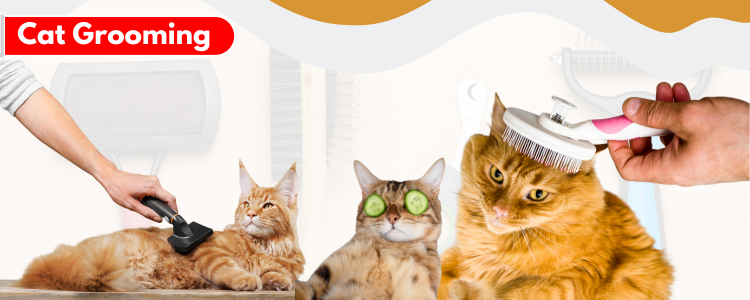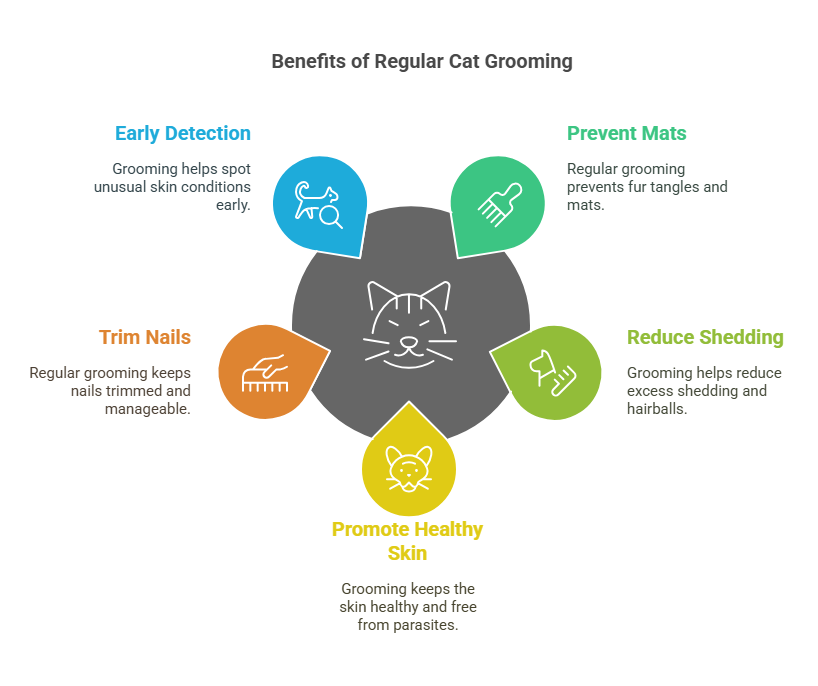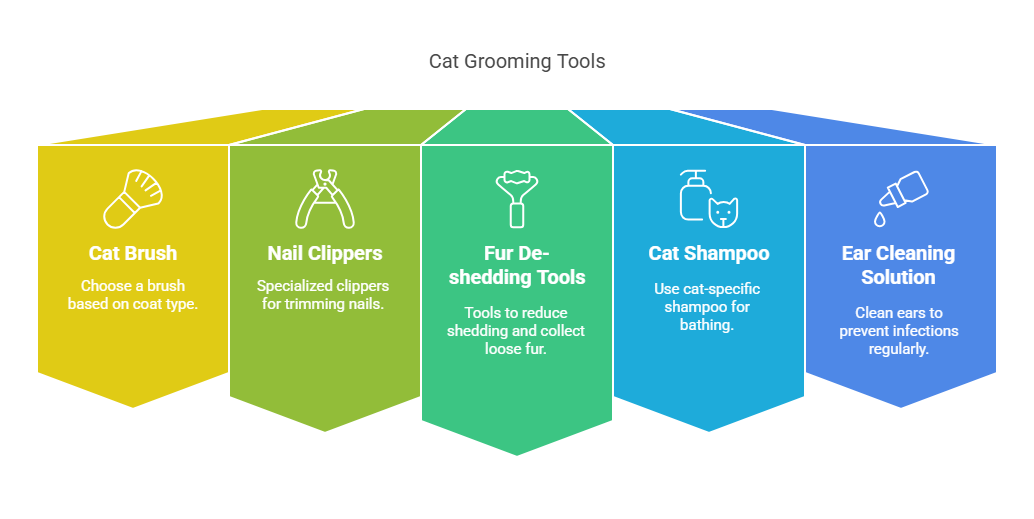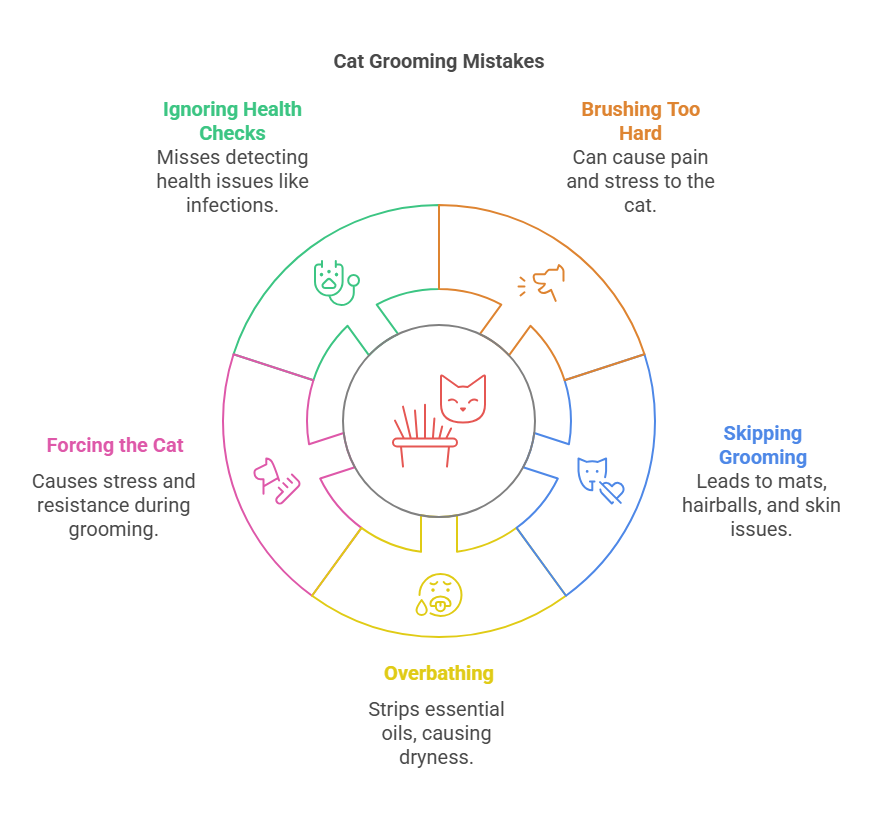Cats are independent creatures, but they still need care and attention. Grooming is one of the most important aspects of a cat’s well-being. Whether your cat has short or long hair, grooming helps maintain a healthy coat, keeps shedding under control, and can prevent common health problems. In this guide, we’ll explore the best cat grooming practices and tips to ensure your feline friend is in top shape.
Why Cat Grooming Is So Important
Cat grooming isn’t just about keeping your pet looking good. It serves several vital functions that impact your cat’s overall health and comfort. Regular grooming can help:
- Prevent mats and tangles in the fur
- Reduce shedding and hairballs
- Keep the coat shiny and healthy
- Promote healthy skin
- Prevent parasites like fleas and ticks
- Keep nails trimmed and manageable
- Spot any unusual skin conditions or lumps early
Without regular grooming, cats can develop a variety of issues, including matted fur, skin infections, and excessive shedding. Some breeds, particularly long-haired cats, require more frequent grooming. Regular grooming sessions also help bond with your pet and reduce stress during visits to the vet.
The Benefits of Cat Grooming
Regular grooming offers many benefits for both you and your cat. Here are some of the key reasons why grooming is so important:
- Health Monitoring: Grooming is a great opportunity to check for health problems, such as lumps, rashes, or parasites.
- Fur and Skin Care: Grooming helps keep your cat’s fur clean, shiny, and free from mats or tangles.
- Bonding Time: Grooming sessions can strengthen your bond with your cat and help it trust you more.
- Reduces Stress: A consistent grooming routine can make trips to the vet or groomers less stressful for your cat.
By incorporating regular grooming into your routine, you can ensure your cat remains healthy and comfortable while minimizing common pet care problems.
Tools and Grooming Kits For Cat Grooming
Having the right tools makes grooming much easier. Here are some of the most essential cat grooming tools:
- Cat Brush: Choose a brush that matches your cat’s coat type. For short-haired cats, a simple slicker brush or a bristle brush works well. Long-haired cats need a comb or a pin brush to reach deep into their fur.
- Nail Clippers: Use specialized cat nail clippers to trim your cat’s nails. Keep the clipper clean to avoid infections.
- Fur De-shedding Tools: These are helpful for cats that shed a lot. A de-shedding tool can help collect loose fur and reduce shedding around your home.
- Cat Shampoo: Occasionally, your cat may need a bath, but it’s crucial to use a cat-specific shampoo to avoid skin irritation.
- Ear Cleaning Solution: Regularly check and clean your cat’s ears to prevent ear infections.
Have a Safe, Hygienic Grooming Environment For Your Cat
Before grooming your cat, ensure the environment is safe and hygienic. A clean grooming space will keep your cat comfortable and reduce the risk of infection. Here’s what to keep in mind:
- Non-Slip Surface: Ensure the grooming area has a stable, non-slip surface so your cat doesn’t feel unsafe or anxious.
- Clean Tools: Always use clean grooming tools to prevent spreading dirt or bacteria.
- Well-Lit Area: Grooming in a well-lit area allows you to see the details clearly and ensure you’re doing the job properly.
- Quiet Environment: Choose a quiet area where your cat won’t be distracted or scared by noise.
Creating a calm and safe grooming environment makes the process easier for both you and your cat.
Preparing Your Cat for Grooming
Some cats may find grooming stressful, so it’s important to prepare them properly:
- Start Young: The earlier you introduce grooming to your cat, the more likely they will become comfortable with it.
- Positive Reinforcement: Reward your cat with treats or affection after every successful grooming session.
- Take It Slow: If your cat is nervous, take small breaks during grooming sessions. Don’t rush.
- Desensitize: Gently touch your cat’s paws, ears, and tail before you begin grooming to help them get used to being handled in these areas.
By gradually preparing your cat for grooming, you reduce stress and make the experience more enjoyable for both of you.
Skin and Fur Care For Your Cat
Skin and fur health is crucial to your cat’s well-being. Here are some tips to maintain a healthy coat:
- Brush Regularly: Regular brushing removes loose fur and prevents mats and tangles. It also helps distribute natural oils across your cat’s skin.
- Check for Fleas and Ticks: While grooming, check your cat’s fur for signs of fleas, ticks, or other pests.
- Use the Right Shampoo: If your cat needs a bath, use a mild, cat-safe shampoo to avoid irritation.
- Hydration: Make sure your cat is drinking enough water, as dehydration can lead to dry skin.
Healthy skin and fur are signs of a well-groomed and happy cat. Regular grooming is the best way to maintain their overall coat health.
Ear Care For Your Cat
Ear care is an essential part of grooming. Regular ear checks help detect potential problems early. Here’s how to care for your cat’s ears:
- Inspect Regularly: Check your cat’s ears for any dirt, redness, or signs of infection.
- Use a Gentle Ear Cleaner: Use a cat-safe ear cleaning solution to remove any dirt or wax build-up.
- Avoid Inserting Objects: Never insert cotton swabs or objects into your cat’s ear canal, as this could cause injury.
Proper ear care helps prevent infections and ensures your cat’s ears stay healthy and clean.
Paw and Nail Care For Your Cat
Caring for your cat’s paws and nails is crucial for their comfort and safety:
- Trim Nails Regularly: Cats’ nails grow quickly and can become sharp. Trim their nails every couple of weeks.
- Check for Cracks: Inspect your cat’s paw pads for any cuts, cracks, or infections. Clean the paws if needed.
- Use Soft Paws: If your cat tends to scratch furniture, consider using soft paw covers to protect your home.
Regular paw and nail care helps prevent injury and keeps your cat’s paws in good shape.
Dental Care For Your Cat
Dental health is often overlooked, but it’s a vital part of your cat’s grooming routine. Poor dental care can lead to gum disease, bad breath, and tooth loss. Here’s how to care for your cat’s teeth:
- Brush Teeth Regularly: Use a cat-specific toothbrush and toothpaste to brush your cat’s teeth. Aim for brushing at least two to three times a week.
- Dental Treats: Offer dental treats or toys designed to help reduce plaque and tartar build-up.
- Regular Vet Check-ups: Schedule annual dental check-ups with your vet to ensure your cat’s teeth are healthy.
Maintaining good dental hygiene can prevent more serious health problems down the road.
Eye Care For Your Cat
Regular eye care is just as important as grooming other parts of your cat’s body. Keep your cat’s eyes healthy by:
- Wiping Away Discharge: If your cat has tear stains or eye discharge, gently wipe the area with a damp cloth.
- Watch for Signs of Infection: If your cat’s eyes are red, swollen, or excessively watery, consult your vet.
- Avoid Touching the Eyes: Only clean the eyes if necessary. Avoid putting pressure on your cat’s eyes during grooming.
Eye care is crucial for your cat’s overall health, and regular cleaning can prevent discomfort and infections.
Common Cat Grooming Mistakes to Avoid
While grooming is essential, there are a few common mistakes that many pet owners make. Avoid these to ensure a smooth grooming routine:
- Brushing Too Hard: Be gentle when brushing your cat’s fur. Rough brushing can cause pain and stress.
- Skipping Regular Grooming: Skipping grooming sessions can lead to mats, hairballs, and skin problems. Keep a consistent grooming schedule.
- Overbathing: Cats don’t need frequent baths. Bathing them too often can strip their skin of essential oils and cause dryness.
- Forcing Your Cat: Never force your cat into a grooming session. If your cat is stressed, take breaks and try again later.
- Not Checking for Health Issues: Grooming is a great opportunity to check for health problems like skin infections, lumps, or flea infestations. Don’t overlook this step.
FAQs About Cat Grooming
How can I make my cat enjoy grooming?
Start grooming your cat at a young age, use positive reinforcement, and go slow. Gradually increase the length of each session.
Can I use human shampoo on my cat?
No, always use a cat-specific shampoo. Human shampoos can irritate your cat’s skin.
How do I deal with mats in my cat’s fur?
Use a comb or detangling tool to carefully work out the mats. If the mats are severe, consider visiting a professional groomer.
Should I groom my cat more during shedding season?
Yes, grooming is especially important during shedding season to remove excess fur and reduce hairballs.
What if my cat has sensitive skin?
If your cat has sensitive skin, use hypoallergenic grooming products and consult your vet for recommendations.
Cat grooming is an essential part of your pet care routine. Whether you have a long-haired or short-haired cat, regular grooming ensures they stay healthy, comfortable, and happy. It also helps prevent common issues like mats, shedding, and hairballs. With the right tools and techniques, grooming your cat can be an enjoyable experience for both of you.




